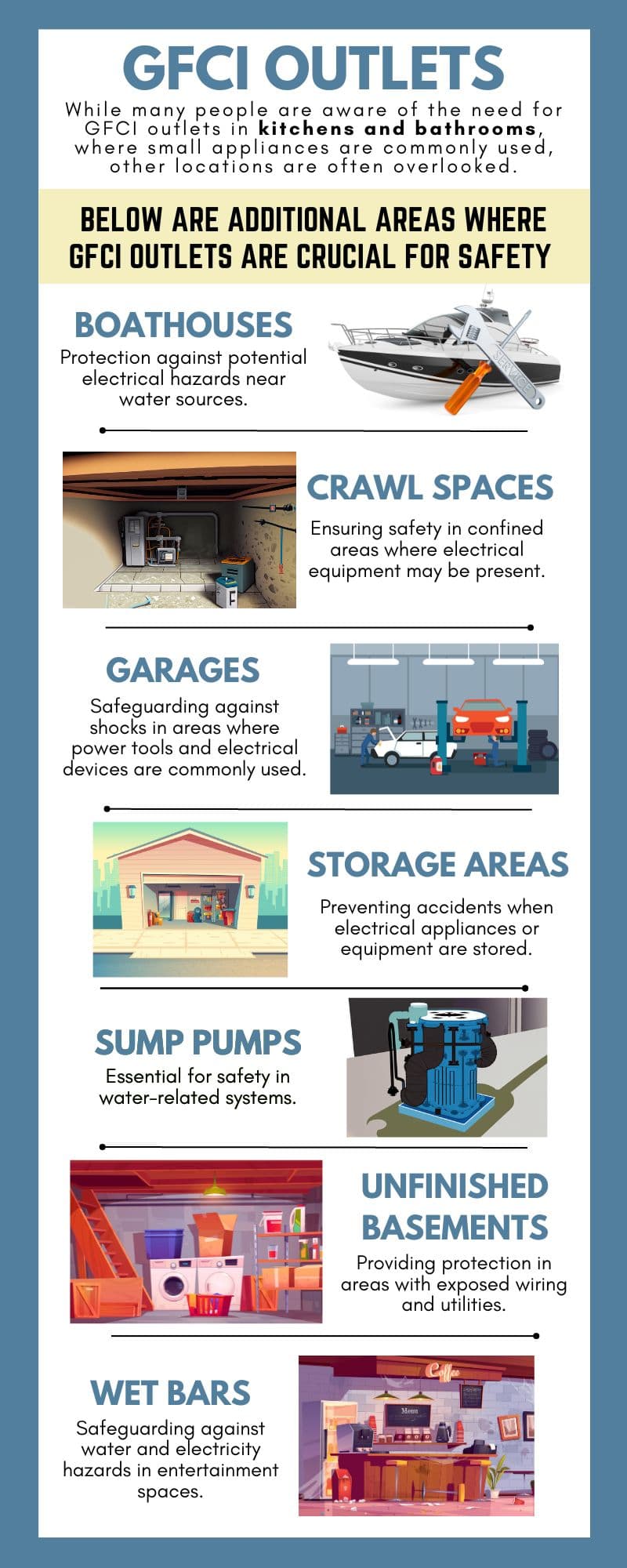circuit breaker definition
circuit breaker ground fault circuit interrupter

Do you have a GFCI outlet installed in the necessary areas of your home?
If you’re unsure or unfamiliar with GFI outlets, it’s important to grasp their significance, functionality, and the locations where they are required.
This article provides an in-depth understanding of GFCI outlets and their role in preventing electrical shocks within your home.
What is a GFCI Outlet?
GFCI outlets, commonly referred to as Ground Fault Circuit Interrupters, are vital components of your electrical system.
Their primary purpose is to protect you from electric shocks caused by faults in your home’s electrical devices. By continuously monitoring input and output currents, GFI outlets detect even the smallest discrepancies, as low as a few milliamps.
Once a fault is detected, the GFCI outlet swiftly cuts off the power supply within 30 milliseconds, significantly reducing the risk of severe injuries.
Differentiating GFCI and GFI
Although GFI (Ground Fault Interrupter) is a widely used term, the correct abbreviation is GFCI. Both terms, however, refer to the same device, the Ground Fault Circuit Interrupter.
How Do a GFCI Outlet Work?
To comprehend the functionality of GFI outlets, it is essential to understand their working principle.
GFCI outlets compare the input current from the hot side to the output current on the neutral side. This continuous comparison ensures a balanced current flow.
If any difference, such as a leakage or ground fault, is detected, the GFI outlet immediately interrupts the electricity flow. This rapid response time mitigates the risk of electric shocks and potential harm to human tissue.
For more on ground fault analysis and protection measures see this study from IOP Science.
Locations Requiring a GFCI Outlet:
To comply with electrical safety standards, GFCI outlets should be installed in specific areas of your home.
While many people are aware of the need for GFI outlets in kitchens and bathrooms, where small appliances are commonly used, other locations are often overlooked.
Here are additional areas where GFI outlets are crucial for safety:
- Boathouses: Protection against potential electrical hazards near water sources.
- Crawl spaces: Ensuring safety in confined areas where electrical equipment may be present.
- Garages: Safeguarding against shocks in areas where power tools and electrical devices are commonly used.
- Storage areas: Preventing accidents when electrical appliances or equipment are stored.
- Sump pumps: Essential for safety in water-related systems.
- Unfinished basements: Providing protection in areas with exposed wiring and utilities.
- Wet bars (if within six feet of a sink): Safeguarding against water and electricity hazards in entertainment spaces.
Additionally, it is imperative to consult with your local building authority to ensure compliance with any additional rules or regulations specific to your region.

The Importance of GFCI Outlet Accessibility
In addition to proper placement, it is key that GFCI outlets are easily accessible to serve their purpose effectively.
Even if installed in critical locations, such as under a tub without an access panel or on a ceiling, the inability to reset the outlet renders it impractical.
Ensuring easy access to GFI outlets is essential for maintaining their functionality and promoting safety.
Installation of GFI Outlets
Professional assistance should be sought for the installation of GFCI outlets.
While it is important to have GFI outlets in all required areas, it is also wise to consider installing them in any location where electrical safety would be prudent.
An electrician can assess your home’s electrical system, recommend suitable GFCI outlet placement, and ensure proper integration with the existing circuit breaker panel and wiring system.

Common Misconceptions about GFI Outlets
To clarify misconceptions surrounding GFI outlets, let’s address a few common myths:
- GFCI outlets are only necessary outdoors or near water sources: Although GFI outlets are essential in such areas, they should also be installed in various locations throughout your home to ensure comprehensive electrical safety.
- GFCI outlets are the same as circuit breakers: While both provide protection against electrical faults, GFI outlets specifically protect against ground faults and minimize the risk of electric shocks.
- GFCI outlets require special maintenance: GFI outlets do not require additional maintenance beyond standard electrical outlets. However, periodic testing using the built-in “test” and “reset” buttons is recommended to ensure their proper functionality.
Maximizing Electrical Safety at Home
While GFI outlets play a crucial role in electrical safety, there are additional measures you can take to enhance overall safety within your home.
Consider implementing the following practices:
- Regular electrical inspections: Schedule periodic inspections by a qualified electrician to identify potential hazards and outdated wiring systems that may pose risks.
- Surge protectors: Use surge protectors to safeguard sensitive electronic devices from power surges and voltage spikes.
- Proper cord management: Avoid overloading electrical outlets, minimize the use of extension cords, and ensure cords are in good condition to prevent overheating and potential hazards.
- Education and awareness: Educate yourself and your family members about basic electrical safety practices, such as avoiding the use of electrical devices near water and refraining from using damaged cords or plugs.
Ground Fault Circuit Interrupters (GFCI) are vital for maintaining electrical safety within your home and protecting your loved ones from potential electrical hazards.
Understanding the functionality, importance, and required locations for GFI outlets is crucial in creating a safe living environment.
By prioritizing the installation and accessibility of GFCI outlets, along with implementing other electrical safety measures, you can significantly reduce the risk of electrical accidents and have peace of mind knowing your home is protected.
Remember, electrical safety should be a priority, and professional assistance should be sought for the proper installation and maintenance of GFI outlets.
By taking necessary precautions and staying informed, you can create a safer living environment for you and your family.